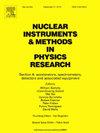用于研究热中子通量变化的PRISMA-36阵列
IF 1.5
3区 物理与天体物理
Q3 INSTRUMENTS & INSTRUMENTATION
Nuclear Instruments & Methods in Physics Research Section A-accelerators Spectrometers Detectors and Associated Equipment
Pub Date : 2025-04-19
DOI:10.1016/j.nima.2025.170547
引用次数: 0
摘要
从2012年到2023年,PRISMA-32阵列在NEVOD实验综合体(莫斯科MEPhI)运行。该阵列的目的是研究广泛的空气阵雨,利用非屏蔽中子探测器探测它们的中子和电子光子成分。为了扩大该设施的能力,包括用中子通量研究宇宙和地球物理现象,对其进行了升级。在这次升级中,增加了一个测量通道来研究中子背景的变化及其影响过程。为此,更换了光电倍增管、集成放大器、数字化电子器件和高压供电系统。本文介绍了升级后的PRISMA-36阵列的结构,并给出了对其“变异”通道主要元件特性的研究结果。讨论了一种识别中子俘获引起的信号的方法及其选择的确定标准。给出了用PRISMA-36阵列的变化通道记录的x1.1级耀斑引起的Forbush衰减的例子。本文章由计算机程序翻译,如有差异,请以英文原文为准。
The PRISMA-36 array for studying variations of the thermal neutron flux
From 2012 to 2023, the PRISMA-32 array operated at the Experimental Complex NEVOD (MEPhI, Moscow). The purpose of the array was to study extensive air showers detecting their neutron and electron-photon components using unshielded neutron detectors. To expand the capabilities of this facility, including the study of cosmic and geophysical phenomena with a neutron flux, its upgrade was carried out. In this upgrade, a measurement channel to study the variations of the neutron background and the processes affecting them was added. To achieve this, the photomultipliers, the integrating amplifiers, the digitalizing electronics and the high-voltage power supply system were replaced. The paper describes the structure of the upgraded array, which was named PRISMA-36, and presents the results of studying the characteristics of the main elements of its “variation” channel. A method for identifying signals caused by neutron capture and the determined criteria for their selection are discussed. An example of a Forbush decrease, caused by a X1.1-class flare and recorded with the variation channel of the PRISMA-36 array, is given.
求助全文
通过发布文献求助,成功后即可免费获取论文全文。
去求助
来源期刊
CiteScore
3.20
自引率
21.40%
发文量
787
审稿时长
1 months
期刊介绍:
Section A of Nuclear Instruments and Methods in Physics Research publishes papers on design, manufacturing and performance of scientific instruments with an emphasis on large scale facilities. This includes the development of particle accelerators, ion sources, beam transport systems and target arrangements as well as the use of secondary phenomena such as synchrotron radiation and free electron lasers. It also includes all types of instrumentation for the detection and spectrometry of radiations from high energy processes and nuclear decays, as well as instrumentation for experiments at nuclear reactors. Specialized electronics for nuclear and other types of spectrometry as well as computerization of measurements and control systems in this area also find their place in the A section.
Theoretical as well as experimental papers are accepted.

 求助内容:
求助内容: 应助结果提醒方式:
应助结果提醒方式:


